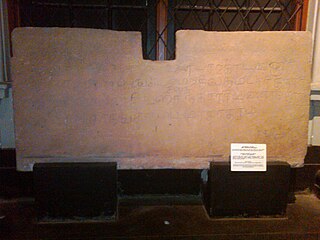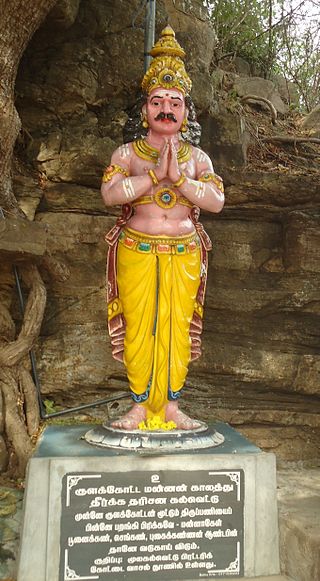
Nandi, also known as Nandikeshvara or Nandideva, is the bull vahana (mount) of the Hindu god Shiva and the first of the Navadurga, Shailaputri. He is also the guardian deity of Kailash, the abode of Shiva. Almost all Shiva temples display stone images of a seated Nandi, generally facing the main shrine.

The Jaffna kingdom, also known as Kingdom of Aryachakravarti, was a historical kingdom of what today is northern Sri Lanka. It came into existence around the town of Jaffna on the Jaffna peninsula and was traditionally thought to have been established after the invasion of Kalinga Magha from Kalinga in India. Established as a powerful force in the north, northeast and west of the island, it eventually became a tribute-paying feudatory of the Pandyan Empire in modern South India in 1258, gaining independence when the last Pandyan ruler of Madurai was defeated and expelled in 1323 by Malik Kafur, the army general of the Delhi Sultanate. For a brief period in the early to mid-14th century it was an ascendant power in the island of Sri Lanka, to which all regional kingdoms accepted subordination. However, the kingdom was overpowered by the rival Kotte kingdom around 1450 when it was invaded by Prince Sapumal under the orders of Parakramabahu VI.

The Arya Chakravarti dynasty were kings of the Jaffna Kingdom in Sri Lanka. The earliest Sri Lankan sources, between 1277 and 1283, mention a military leader of this name as a minister in the services of the Pandyan Empire; he raided the western Sri Lankan coast and took the politically significant relic of the Buddha's tooth from the Sinhalese capital city of Yapahuwa. Political and military leaders of the same family name left a number of inscriptions in the modern-day Tamil Nadu state, with dates ranging from 1272 to 1305, during the late Pandyan Empire. According to contemporary native literature, such as Cekaracecekaramalai, the family also claimed lineage from the Tamil Brahmins of the prominent Hindu pilgrimage temple of Rameswaram in the modern Ramanathapuram District of India. They ruled the Jaffna kingdom from the 13th until the 17th century, when the last of the dynasty, Cankili II, was ousted by the Portuguese.
Kalinga Magha or Gangaraja Kalinga Vijayabahu was an invader from the Kingdom of Kalinga who usurped the throne from Parakrama Pandyan II of Polonnaruwa in 1215. A massive migration followed of Sinhalese people to the south and west of Sri Lanka, and into the mountainous interior, as they attempted to escape his power. Magha was the last ruler to have his seat in the traditional northern seat of native power on the island, known as Rajarata; so comprehensive was his destruction of Sinhalese power in the north that all of the successor kingdoms to Rajarata existed primarily in the south of the island.
Most of the pre-modern coinage used in Sri Lanka or coins used in pre-Christian Sri Lanka can be categorised as punch-marked coins, tree and swastika coins, elephant and swastika coins and Lakshmi plaques.
Vira Alakesvara, also known as Vijayabahu VI, was the last King of Gampola who ruled from 1397 to 1411. He was the last prominent member of the Alagakkonara family.

The Kotagama inscription found in Kegalle District in Sri Lanka is a record of victory left by the Aryacakravarti kings of the Jaffna Kingdom in western Sri Lanka. The inscription reads;
"The women-folks of lords of Anurai who did not submit to Ariyan of Cinkainakar of foaming and resounding waters shed tears from eyes that glinted like spears and performed the rites of pouring water with gingerly seed from the bejeweled lotus like hands."
Martanda Cinkaiariyan ascended the throne of Jaffna Kingdom under the throne name Pararasasekaram III. He is one of the early Aryacakravarti kings about whom historical and epigraphical evidence is available. He was noted by Ibn Battuta in his well-known travelogue as well as he has left behind a few inscriptions. He oversaw the international trade of the Jaffna kingdom with Yemen via the kingdom's powerful trading ships. Martanda Cinkaiariyan accompanied Battuta to the peak of Sivanoli Padam Malai along with Yogis and other Hindus and companions of the king who visited the sacred Shiva site annually.

Setu coins or Setu bull coins are found in large quantities in the northern part of Sri Lanka and in Southern India. Codrington in his book Ceylon Coins and Currency published in 1924 and Mitchiner in his book Oriental Coins published in 1978 have clearly pointed out that the traditional design of Sri Lanka standing King Type Copper Massa (coins) of the Jaffna Kingdoms belongs to the Aryacakravarti dynasty from 1284 AD to 1410 AD. Setu coins were previously attributed to the Setupati Princes of Ramanathapuram in South India. There are two series one in the issued from the 13th to the 15th centuries and the other after the brief loss of sovereignty to the rival Kotte kingdom from 1450 to 1467 and reconstitution of the Kingdom. Even during the rule of Sapumal Kumaraya coins were issued in Jaffna that was distinct. Three types of this series are illustrated below. The obverse of these coins have a human figure flanked by lamps and the reverse has the Nandi (bull) symbol, the legend Sethu in Tamil with a crescent moon above.
Kulasekara Cinkaiariyan is considered to be the first of the Aryacakravarti dynasty kings to establish his rule over the Jaffna Kingdom in modern Sri Lanka.
Kandarodai is a small hamlet and archaeological site of Chunnakam town, a suburb in Jaffna District, Sri Lanka. The notable ancient Buddhist monastery referred to as Kadurugoda Vihara is situated in Kandarodai.

Nissanka Malla, also known as Keerti Nissanka and Kalinga Lokesvara was a king of Polonnaruwa who ruled the country from 1187 to 1196. He is known for his architectural constructions such as the Nissanka Lata Mandapaya, Hatadage and Rankot Vihara, as well as for the refurbishment of old temples and irrigation tanks.

The Kingdom of Kotte, named after its capital, Kotte, was a Sinhalese kingdom that flourished in Sri Lanka during the 15th century.
When to date the start of the history of the Jaffna kingdom is debated among historians.
Vickrama Cinkaiariyan was the fourth of the Aryacakravarti kings of Jaffna Kingdom. Author of the book “Ancient Jaffna” C. Rasanayagam calculated that he has been ruled Jaffna from 1279 to 1302. Yalpana Vaipava Malai says during his rule the county was in disorder. Riot occurred between Sinhalese and Tamils. Vickrama Cinkaiariyan ordered death sentences 17 Sinhalese and imprisoned many Sinhalese after the murder of 2 Tamils.

This is a bibliography of works on Sri Lanka.

Kulakkottan was an early Chola king and descendant of Manu Needhi Cholan who was mentioned in chronicles such as the Yalpana Vaipava Malai and stone inscriptions like Konesar Kalvettu. His name Kulakkottan means 'builder of tank and temple'.
The Kotte conquest of the Jaffna kingdom was an expedition against the Jaffna kingdom by the Kotte kingdom. The Kotte's campaign had several phases against Jaffna dated between A.D. 1449–50 and 1453–54. The first campaign, led by Prince Sapumal, adopted son of Parakramabahu VI in 1450. In the second campaign, Prince Sapuma defeated Kanakasooriya Cinkaiariyan and ruled the region nearly 17 years as a representative of Kotte.










